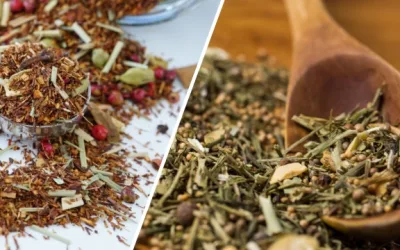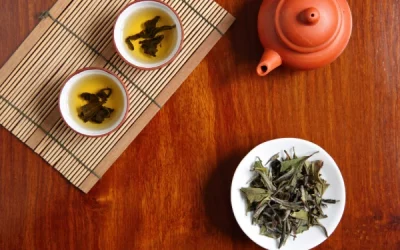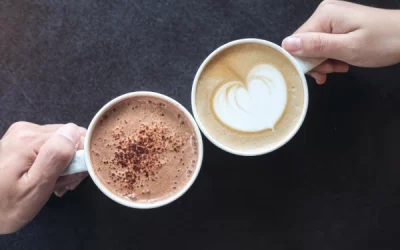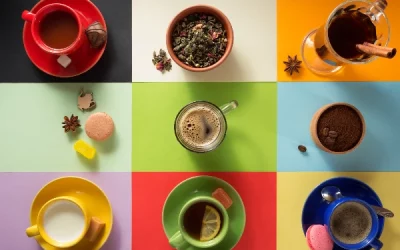Did you know that green tea has been celebrated for centuries, not just for its refreshing taste, but also for its extraordinary health benefits? In contrast, chamomile has carved its niche as a soothing herbal remedy, famed for promoting relaxation and sleep. As health-conscious individuals and tea enthusiasts explore natural remedies, understanding the strengths and differences between green tea and chamomile becomes crucial. This article offers a comprehensive comparison of their benefits, uses, and cultural significance to help you choose the perfect brew for your needs.
Table of Content
- What are the key difference between green tea and chamomile tea?
- How do the flavour profiles of green tea and chamomile differ?
- What are the cultural significances of green tea and chamomile?
- How can one prepare green tea and chamomile for optimal benefits?
- Can green tea and chamomile be consumed together?
- Conclusion
What are the key difference between green tea and chamomile tea?
Green tea and chamomile tea differ in several key aspects, including their source, caffeine content, flavor profile, and health benefits. Here’s a comparison:
1. Source
- Green Tea: Made from the leaves of the Camellia sinensis plant. The leaves are lightly steamed or pan-fired to prevent oxidation, which preserves their green color.
- Chamomile Tea: Herbal tea made from the dried flowers of the Matricaria chamomilla or Chamaemelum nobile plant (commonly known as chamomile).
2. Caffeine Content
- Green Tea: Contains caffeine, though less than black tea or coffee. It typically has about 20-50 mg of caffeine per cup.
- Chamomile Tea: Naturally caffeine-free, making it a popular option for people who are sensitive to caffeine or want a calming beverage before bed.
3. Flavor
- Green Tea: Has a light, earthy, slightly bitter taste, which can vary depending on how it’s brewed and the variety of tea leaves used.
- Chamomile Tea: Has a mild, sweet, and floral flavor with hints of apple or honey, making it smooth and soothing.
4. Health Benefits
- Green Tea:
- High in antioxidants, particularly catechins and polyphenols.
- May support weight loss, improve brain function, and lower the risk of heart disease.
- Has potential cancer-fighting properties due to its antioxidant content.
- Chamomile Tea:
- Known for its calming and sleep-inducing properties.
- Helps with digestion and can reduce bloating and indigestion.
- May have anti-inflammatory and antioxidant effects, useful for skin health and reducing stress.
5. Use in Traditional Medicine
- Green Tea: Used in traditional Chinese and Japanese medicine for its stimulating effects and health benefits.
- Chamomile Tea: Used in traditional herbal medicine for centuries as a remedy for anxiety, insomnia, and digestive issues.
6. Best Time to Drink
- Green Tea: Typically consumed during the day due to its caffeine content. It’s refreshing in the morning or after meals.
- Chamomile Tea: Often consumed in the evening or before bed to promote relaxation and sleep.
Both teas offer distinct health benefits and are enjoyed for different purposes!
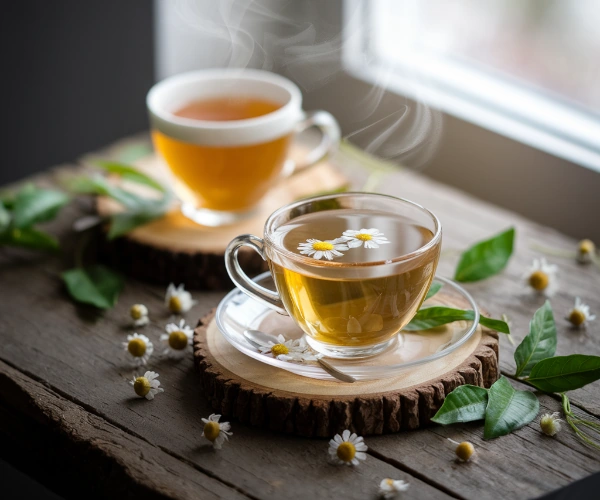
How do the flavour profiles of green tea and chamomile differ?
When it comes to flavour, green tea and chamomile are like polar opposites on the taste spectrum. Ever tried biting into a lemon versus popping a marshmallow into your mouth? Yeah, it’s that kind of different.
Green tea is often described as earthy or grassy, while chamomile has a more delicate, floral, and slightly sweet flavour. They might both be called “tea,” but their flavours couldn’t be more different.
This divergence isn’t just something your taste buds pick up; it also affects how these teas are brewed and enjoyed, creating an entire experience around each cup.
Now, you may not think flavour matters much beyond taste, but considering their different aromas, preparation methods, and even culinary applications can turn you into a proper tea connoisseur in no time. So let’s dive into what makes these teas unique, starting with the specifics of green tea’s flavour.
What flavours can one expect from green tea?
Green tea offers what’s best described as a complex taste adventure.
- Earthy and Grassy: It’s like walking through a forest, with all its natural goodness hitting your nostrils.
- Bitterness: A mild bitterness that’s more of an accent than a main feature.
- Umami: Yes, that elusive fifth taste. Think of a savoury broth.
- Vegetal: Spinach or fresh-cut grass vibes.
- Nutty or Sweet: Depending on the specific type, you might catch a nutty or sweet undertone.
In layman’s terms, green tea is for those who appreciate subtle, evolved tastes. It’s sort of like the jazz of the tea world—might not be for everyone, but once you get it, you really get it.
Now, brewing green tea isn’t rocket science but it does require a bit of finesse. Use water that’s around 80-85°C (not boiling, unless you like your tea to punch you in the face with bitterness), and steep for just 2-3 minutes. Over-brewing can turn this delightful cup of finesse into something resembling swamp water.
How does chamomile’s flavour enhance its appeal?
Chamomile, on the other hand, is like the floral serenade in the tea world.
- Floral: Like sipping on a bouquet. If flowers could sing, this would be their love song.
- Sweet and Fruity: Subtle, not like a sugar bomb, more like nature’s gentle kisses.
- Apple-Like: A mild apple essence that’s both calming and inviting.
- Honeyed: Sometimes there’s this honey-like hue to its flavour, creating a smooth sip.
Chamomile’s gentle flavour makes it perfect for those who prefer softer, more soothing tastes. It’s the kind of drink that says, “Let’s just kick back and relax, shall we?”
When brewing chamomile, forget about the delicate dance green tea requires. A full boil will do, and steep for around 5-6 minutes. You can’t really mess it up, which makes it the perfect partner for those moments when life’s hitting you with all sorts of curveballs.
Can green tea and chamomile be blended for a unique taste?
Now, blending these two might sound like introducing oil to water, but you’d be in for a tasty surprise.
- Balanced Bitterness and Sweetness: The green tea’s earthiness counterbalances chamomile’s sweetness.
- Aromatic Bliss: Imagine an earthy base note with a floral top note.
- Gourmet Creation: It’s like composing a symphony for your taste buds.
Blending might seem like a hippie experiment, but it’s rather a calculated move. It allows the bitter edge of green tea to meld seamlessly with chamomile’s gentle touch. What you get is a dynamic yet harmonious cup, perfect for those undecided days.
Preparation for a blend? Easy peasy. Boil your water, steep the green tea for around 2 minutes, then throw in your chamomile and let it all steep together for another 3-4 minutes. Voila, you’re sipping a masterpiece.
During World War II, British soldiers were often issued tea rations to keep morale high. While black tea was the staple, a shortage led them to improvise with whatever herbs they could find.
That’s when chamomile and other herbs became the unsung heroes of the tea world. This not only helped soldiers relax—since chamomile is a well-known stress reliever—but also diversified their palates during those hard times.
A historical nod to the adaptability and necessity of tea blends, proving that sometimes constraints lead to delicious innovations.
What are the cultural significances of green tea and chamomile?
Ever wondered why green tea feels like a cultural ceremony in a cup or why chamomile seems to be everyone’s go-to granny remedy? Let’s break it down.
Green tea and chamomile have deep cultural roots, rich historical significance, and are steeped in traditional practices. From ancient medicinal uses to contemporary trends, these teas have woven themselves into the fabric of different societies.
How has green tea been integrated into Asian cultures?
Green tea isn’t just a drink in Asia; it’s practically a lifestyle. The traditions and rituals surrounding it make you wonder if you’re making a cuppa or preparing to meditate.
- Japan: The Japanese tea ceremony, or ‘Chanoyu’, is more of an art form than a mere act of brewing tea. It’s about aesthetics, mindfulness, and finding peace through the simple act of pouring and sipping.
- China: Green tea originated here, with practices dating back to the Tang Dynasty. It’s used in everything from cordial welcomes to spiritual rituals.
- Korea: Over there, tea ceremonies, known as ‘Darye’, promote relaxation, etiquette, and deep conversations.
- Vietnam: Green tea is often found in every household, where it is served to guests as a sign of respect and hospitality.
Green tea wasn’t just for sipping; it also played roles in traditional Chinese medicine as a cure-all tonic. Flu? Drink tea. Headache? Cup of Green tea. Broken heart? Green tea and a good cry.
What is chamomile’s role in herbal traditions worldwide?
Chamomile is the world’s herbal teddy bear. Known for its calming properties, it’s been used far and wide to fix just about anything that ails you.
- Europe: Greek and Roman doctors handed it out like sweets, and who can blame them? It’s been used for relaxation, digestive issues, and even to promote restful sleep.
- Middle East: Chamomile tea is a household staple, often given to children and adults alike to soothe the mind and stomach.
- Egypt: The ancient Egyptians loved chamomile so much they used it in their embalming process and as an offering to the gods.
- Mexico: Used in traditional medicine to treat anxiety, indigestion, and a host of other ailments.
Chamomile’s flowers have been brewed into calming infusions, used in skincare concoctions, and even incorporated into mummification rituals.
How have modern trends influenced the consumption of these teas?
Move over coffee, the world has gone tea-mad, and green tea and chamomile are riding that wave like seasoned surfers.
- Health Craze: With everyone becoming a health guru overnight, both teas have had a massive boost. Green tea is loved for its antioxidants and metabolism-boosting properties, while chamomile is hailed for reducing stress and enhancing sleep quality.
- Cafés: Trendy cafes now have intricate tea menus including fancy green tea lattes and chamomile-infused mocktails.
- Organic Movement: The shift towards organic, non-GMO, and sustainable farming has favoured these herbal teas, pushing them further into the spotlight.
- Fitness and Wellness: Influencers, yoga instructors, and life coaches swear by their benefits, making them the poster children for healthy living.
Streamlining the drinks we consume has never been trendier. Green tea has found its home in the world of Instagram-worthy matcha bowls and chamomile serenades us in modern-day spa retreats.
About 2500 years ago, a Chinese emperor named Shen Nong was boiling water under a tree when some leaves blew into his pot, creating the first-ever cup of tea. Emperor Nog, being the curious soul he was, decided to taste it. One sip and he declared it to be invigorating. The best accidental discovery ever!
So next time you brew a cup, know that you’re participating in a history as rich as the aroma itself.
How can one prepare green tea and chamomile for optimal benefits?
Ah, green tea and chamomile—two wonderful brews that could easily become the highlight of your day. Each boasts a unique profile of health benefits, characteristics, and preparation requirements. But to reap the full rewards, you need to do more than dump a bag in hot water and call it a day.
Let’s break down the best practices for preparing each to maximise their health benefits and flavour. We’ll discuss brewing techniques, water temperature, steeping times, serving suggestions, and storage tips.
When it comes to brewing techniques, precision is key. Each type of tea has its own ‘Goldilocks’ zone—too hot, too cold, too long, too short—and you could miss out on vital benefits or flavourful nuances.
What is the ideal brewing temperature for green tea?
Grab your thermometer, because green tea demands accuracy. Unlike your rugged builder’s tea, green tea is a picky little beverage that cringes at boiling water.
- Water temperature: Ideally, you want to be between a comfy 70-80°C (that’s 158-176°F for those stuck in Fahrenheit purgatory).
- Steeping time: Keep it short and sweet. A mere 2 to 3 minutes will suffice.
- Tools: A kettle with temperature control will make your life easier, but if you’ve only got a standard kettle, just let the boiling water sit for a bit to cool down.
- Serving suggestion: Feel free to add a slice of lemon or a teaspoon of honey, but don’t drown it in sugar. You’re drinking green tea for the health benefits, remember?
- Storage tips: Seal it in an airtight container. Green tea is not a fan of light, moisture, or strong odours.
Then there’s chamomile—a completely different beast. This caffeine-free herbal wonder is more forgiving, like a grandma who lets you get away with sneaking cookies before dinner (thanks, Grandma).
How long should chamomile tea be steeped?
Patience is key with chamomile. Let it infuse well to unleash all its soothing properties.
- Water temperature: Heat the water to a steady 90-95°C (194-203°F).
- Steeping time: Aim for 5 to 10 minutes. Seriously, be patient.
- Tools: You can use a teapot or individual tea bags, though loose chamomile flowers often deliver better flavour.
- Serving suggestion: Add a dollop of honey or a splash of milk. Even a sprinkle of cinnamon could make things interesting.
- Storage tips: Store it as you would store green tea—airtight, away from sunlight, and in a cool, dry place.
While both teas have their unique prep needs, the real magic lies in the details. Enhancing their flavours can transform a good cup of tea into an exceptional one.
Are there any tips for enhancing the flavour of these teas?
Yes, there are! A few tweaks here and there can elevate your tea-sipping experience from mundane to marvellous.
- Green tea tricks: A slice of lemon or lime can add a zesty punch. A tiny dab of honey brings out the tea’s delicate notes. For an adventurous twist, try adding a few fresh mint leaves.
- Chamomile hacks: Nudge the flavour profile with a dash of vanilla extract. Honey not only sweetens but complements its floral notes. Fresh herbs like rosemary or spearmint can also work wonders.
- Blending: Feel free to mix green tea with other herbal infusions. Chamomile pairs wonderfully with peppermint or lavender for a relaxing, aromatic blend.
- Serve it cold: Both green tea and chamomile make excellent iced teas. Just ensure you brew them strong, as the ice will dilute the flavour.
Getting it right isn’t just about the immediate pleasure. High-quality, well-prepared tea can be a ritual, a health tonic, and even a mood-booster. Ancient civilisations knew this well.
Take, for example, the Buddhist monk Saicho, who is credited for introducing tea to Japan from China in 804 CE. This wasn’t just about beverages; it was about integrating tea into meditation practices.
These folks understood that a perfectly brewed cup could be both soul-soothing and life-enhancing. Their meticulous attention to how tea was prepared laid the groundwork for centuries of tea culture that we still benefit from today.
Happy brewing! Whether you’re more into the energetic kick of green tea or the calming embrace of chamomile, a well-made cup is just a few careful steps away.
Can green tea and chamomile be consumed together?
Let’s face it, tea drinkers have endless options. Green tea and chamomile—two fan-favourites—each boast their own set of kudos in the world of natural remedies. But mixing them together?
That idea probably gives you pause. Fear not, let’s get into it, because these two might just be the power couple you didn’t know you needed.
Green tea’s got the caffeine to kick-start your day and loads of antioxidants to boot. Chamomile, meanwhile, soothes like a warm cuddle, helping you wind down after a long day.
Combining the two might sound like a juicing nightmare, but it’s actually a lot more harmonious than you’d expect. Blending teas is like creating an art; get the balance right and you’re in for a treat, taste-wise and health-wise.
Combining these teas could offer a smorgasbord of benefits, leading to intriguing taste combinations, and a raft of health gains. Of course, personal preferences—and your tolerance for caffeine or herbal notes—also play a role.
So yes, you can drink them together, and here’s why you might want to give it a go.
What are the benefits of combining green tea and chamomile?
The cocktail-punch these two teas pack together is actually pretty impressive. Think of it as creating the Wonder Twins of tea.
- Balanced Energy: Green tea’s caffeine can wake you up, while chamomile can prevent the jitters.
- Rich in Antioxidants: Both teas are loaded with antioxidants, bolstering your defences against those pesky free radicals.
- Calm Alertness: Achieve the zen-like focus you’ve been pining for. Green tea sharpens your mind; chamomile mellows you out.
- Improved Digestion: Both teas are great for your gut. Chamomile soothes, and green tea aids metabolism.
- Synergistic Effect: These two together can potentially enhance each other’s properties, making the blend more effective than consuming them separately.
You’re essentially hitting multiple birds with one stone: energy, relaxation, antioxidants, and digestive health all in one tasty cup.
How can one effectively blend these two teas?
There’s a bit of an art to blending green tea and chamomile. Think of yourself as a mixologist, just without the snazzy cocktail shaker.
- Ratio and Balance: Use a 1:1 ratio to start. Adjust according to your preference for caffeine or herbal lightness.
- Infusion Time: Green tea shouldn’t steep too long—usually 2-3 minutes. Chamomile can steep a bit longer, around 5 minutes. Try a staggered approach.
- Temperature Control: Green tea prefers cooler water, around 80°C. Chamomile is less fussy. Pour water over green tea first, then add chamomile.
- Blending Loose Leaves: Try blending loose leaves instead of using teabags for better flavour control.
- Experiment: Add a slice of lemon, a hint of honey or even some fresh mint to enhance and complement the flavours.
Mastering the blend takes a bit of trial and error, but the quest is half the fun. Soon, you’ll have a custom tea blend that’s unique to your taste.
Are there any drawbacks to drinking them together?
Nothing’s perfect, right? The combo might not be to everyone’s liking. Here’s what you should keep in mind:
- Overwhelming Flavours: The subtlety of chamomile can get drowned out by the stronger green tea if not properly balanced.
- Caffeine Sensitivity: If you’re particularly sensitive to caffeine, green tea’s jolt might undermine chamomile’s calming effect.
- Digestive Effects: While generally good for digestion, too much can lead to an overly active digestive system.
- Potential Allergies: Some people might have mild reactions to chamomile. Always start slow if you’re trying this blend for the first time.
- Taste Preferences: Taste can be subjective. Some might love the fusion, others might find it odd.
With these potential downsides addressed, it’s clear that some may embrace this blend, while others might prefer to keep their teas segregated in their own porcelain borders.
Back in the Tang dynasty (7th century China), Lu Yu, often dubbed the Sage of Tea, penned the first ever tea book, “The Classic of Tea”. This treatise not only explored various aspects of teas but also underscored the art of blending different tea leaves to create harmonious flavours and enhanced health benefits.
Lu Yu’s work was a pioneering effort in understanding and appreciating the complexities and synergies in teas. If you ever feel like a mad scientist in your kitchen, remember you’re following in the footsteps of tea legends!
Conclusion
As I reflect on the enchanting world of green tea versus chamomile, I’m reminded of their unique characteristics that make each a vital part of a health-conscious lifestyle.
Green tea, brimming with potent antioxidants and boasting metabolism-boosting properties, offers a myriad of benefits ranging from heart health to cognitive enhancement. Its invigorating nature makes it a favourite among those seeking alertness and vitality. In contrast, chamomile stands as a gentle ally in promoting relaxation and sleep, its calming effects woven into the very fabric of herbal traditions across the globe.
The caffeine content in each tea underscores their distinct roles: green tea energises, while chamomile beckons one to unwind in the evening tranquillity. Their divergent flavour profiles – the grassy notes of green tea versus the floral, soothing essence of chamomile – speak to personal preferences and culinary versatility, illustrating how these brews can coexist beautifully on our tea shelves.
Delving into the cultural roots of these teas only reinforces their enduring significance. They are more than just beverages; they represent rituals, therapies, and cherished moments across various cultures. However, it is crucial to consider potential side effects associated with their consumption, reminding us that vigilance and personalised approaches to health are paramount.
In preparing these teas for optimal enjoyment and benefit, I’ve learned that the careful selection of brewing techniques can greatly enhance flavour and potency. And the possibility of blending green tea with chamomile opens a door to new experiences, marrying the vibrant energy of one with the calming embrace of the other.
Ultimately, my exploration of green tea and chamomile has led me to appreciate not only their individual merits but also the wisdom of moderation and balance in our dietary choices. As you ponder your next tea selection, I invite you to reflect on this: How can you incorporate these ancient brews into your daily rhythm for a healthier, more harmonious lifestyle?
Resources
- Effect of Chamomile on the Complications of Cancer: A Systematic Review
- Green and Chamomile Teas, but not Acarbose, Attenuate Glucose and …
- The effects of chamomile extract on sleep quality among elderly people …
- Effects of chamomile (Matricaria chamomilla L.) on sleep: A systematic …
- Green tea may lower heart disease risk – Harvard Health
- Effect of green tea consumption on blood lipids: a systematic review …
- Beneficial effects of green tea: A literature review – PMC
- The effects of green tea on weight loss and weight maintenance … – PubMed
- Therapeutic effects of green tea as an antioxidant on oral health- A …
- A Review of the Role of Green Tea (Camellia sinensis) in Antiphotoaging, Stress Resistance, Neuroprotection, and Autophagy



